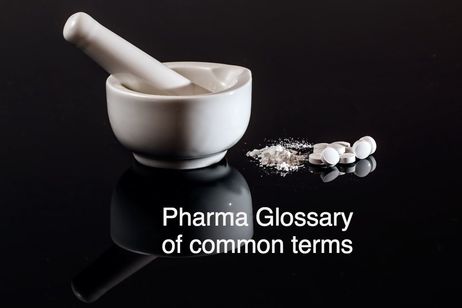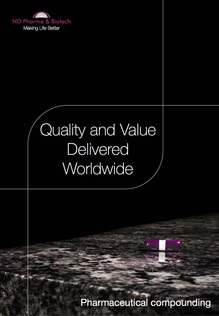What is Pharmaceutical Compounding?
EUROPE
_____________
The preparation of medicinal products in pharmacies are not harmonized all over Europe; there are only some common definitions.
Compounding activity rather falls under the national competencies of individual European countries.
The first European directive of medicinal product was introduced in the 1965, but the compounding activity of the pharmacies was not considered. This concept was introduced with the Directive 89/341/CE that amended Directive 65/65/CE.
Here was defined:
Magistral formula: any medicinal product prepared in a pharmacy in accordance with a prescription for an individual patient.
Officinal formula: any medicinal product which is prepared in a pharmacy in accordance with the prescriptions of a pharmacopoeia and is intended to be supplied directly to the patients served by the pharmacy in question.
These definitions are repeated in the Directive 2001/83/CE, which is still in force.
This directive exempts “pharmaceutical preparations” from the industrial procedures, such as manufacturing and marketing authorizations.
This approach has been recently confirmed by the European Pharmacopoeia monograph on “pharmaceutical preparations”: they are defined as medicinal products generally consisting of active substances that may be combined with excipients, formulated into a dosage form suitable for the intended use, where necessary after reconstitution, presented in a suitable and appropriately labelled container.
Pharmaceutical preparations may be licensed by the competent authority or unlicensed and compounded to meet the specific need of a patient according to current legislation.
They are distinguished in two categories:
Extemporaneous preparations (according to Directives 65/65/CE: magistral formula), i.e. pharmaceutical preparations individually prepared for a specific patient or patient group, supplied after preparation;
Stock preparations, i.e. pharmaceutical preparations prepared in advance and stored until a request for a supply is received.
Following this definition, in some European countries it is allowed to prepare in stock other than officinal formulas also magistral formulas, in order to have an immediate availability of the product for the next dispensation.
USA
In the USA, compounding is currently defined by the National Association of Boards of Pharmacy (NABP) as preparation of components into a drug product as the result of a practitioner’s prescription drug order or initiative based on the practitioner/patient/pharmacist relationship in the course of professional practice.
Compounding includes the preparation of drugs or devices before receiving prescription drug orders based on routine, regularly observed prescribing patterns.
In chapter <795>, “Pharmaceutical Compounding – Non-sterile Preparations”, the US Pharmacopoeia defines compounding as the preparation, mixing, assembling, altering, packaging and labelling of a drug, drug-delivery device, or device in accordance with a licensed practitioner’s prescription, medication order, or initiative based on the practitioner-patient-pharmacist-compounder relationship in the course of professional practice.
Therefore, the US legislation aims to highlight the importance of the application field of pharmacy preparations and to make distinction from the industrial products.
EUROPE
_____________
The preparation of medicinal products in pharmacies are not harmonized all over Europe; there are only some common definitions.
Compounding activity rather falls under the national competencies of individual European countries.
The first European directive of medicinal product was introduced in the 1965, but the compounding activity of the pharmacies was not considered. This concept was introduced with the Directive 89/341/CE that amended Directive 65/65/CE.
Here was defined:
Magistral formula: any medicinal product prepared in a pharmacy in accordance with a prescription for an individual patient.
Officinal formula: any medicinal product which is prepared in a pharmacy in accordance with the prescriptions of a pharmacopoeia and is intended to be supplied directly to the patients served by the pharmacy in question.
These definitions are repeated in the Directive 2001/83/CE, which is still in force.
This directive exempts “pharmaceutical preparations” from the industrial procedures, such as manufacturing and marketing authorizations.
This approach has been recently confirmed by the European Pharmacopoeia monograph on “pharmaceutical preparations”: they are defined as medicinal products generally consisting of active substances that may be combined with excipients, formulated into a dosage form suitable for the intended use, where necessary after reconstitution, presented in a suitable and appropriately labelled container.
Pharmaceutical preparations may be licensed by the competent authority or unlicensed and compounded to meet the specific need of a patient according to current legislation.
They are distinguished in two categories:
Extemporaneous preparations (according to Directives 65/65/CE: magistral formula), i.e. pharmaceutical preparations individually prepared for a specific patient or patient group, supplied after preparation;
Stock preparations, i.e. pharmaceutical preparations prepared in advance and stored until a request for a supply is received.
Following this definition, in some European countries it is allowed to prepare in stock other than officinal formulas also magistral formulas, in order to have an immediate availability of the product for the next dispensation.
USA
In the USA, compounding is currently defined by the National Association of Boards of Pharmacy (NABP) as preparation of components into a drug product as the result of a practitioner’s prescription drug order or initiative based on the practitioner/patient/pharmacist relationship in the course of professional practice.
Compounding includes the preparation of drugs or devices before receiving prescription drug orders based on routine, regularly observed prescribing patterns.
In chapter <795>, “Pharmaceutical Compounding – Non-sterile Preparations”, the US Pharmacopoeia defines compounding as the preparation, mixing, assembling, altering, packaging and labelling of a drug, drug-delivery device, or device in accordance with a licensed practitioner’s prescription, medication order, or initiative based on the practitioner-patient-pharmacist-compounder relationship in the course of professional practice.
Therefore, the US legislation aims to highlight the importance of the application field of pharmacy preparations and to make distinction from the industrial products.
Veterinary Compounding
On countries and territories where Veterinary Compounding is permitted by Law
ND Pharma & Biotech will rely on our local Representatives, Agents and Distributors to serve such markets.
ND Pharma & Biotech will rely on our local Representatives, Agents and Distributors to serve such markets.
PHARMACOLOGY GLOSSARY OF COMMON TERMS.
Definitions of commonly used pharmacological terms
Absorbance:
Absorbance is used for assays such as ELISA assays, protein and nucleic acid quantification or enzyme activity assays (i.e. in the MTT assay for cell viability). A light source illuminates the sample using a specific wavelength (selected by an optical filter, or a monochromator), and a light detector located on the other side of the well measures how much of the initial (100 %) light is transmitted through the sample: the amount of transmitted light will typically be related to the concentration of the molecule of interest.
ADME:An acronym in pharmacokinetics and pharmacology for absorption, distribution, metabolism, and excretion, and describes the disposition of a pharmaceutical compound within an organism.
Agonist:
A drug capable of binding and activating a receptor, leading to a pharmacological response that may mimic that of a naturally occurring substance. It can be classified as full, partial or inverse.
Full agonist:
Capable of eliciting a maximal response as it displays full efficacy at that receptor.
Partial agonist:
Binds to and activates a receptor but is only able to elicit partial efficacy at that receptor. A maximal effect cannot be produced, even when the concentration is increased. When full and partial agonists are present the partial agonist may act as a competitive antagonist.
Inverse agonist:
Produces an effect that is pharmacologically opposite to an agonist, yet acts at the same receptor. The receptor must elicit intrinsic or basal activity in the absence of a ligand and the addition of an inverse agonist will decrease the activity below the basal level. A receptor that possesses basal activity is the GABAA receptor; agonists have a sedative effect whilst inverse agonists have an anxiogenic effect.
Antagonist:
Does not produce a biological response on binding to a receptor but instead blocks or reduces the effect of an agonist. It may be competitive or non-competitive.
Competitive antagonism:
Drug binds selectively to a receptor without causing activation but in such a way to prevent binding of the agonist. The antagonism may be reversible; the effect can be overcome by increasing the concentration of the agonist, which will lead to a shift in the equilibrium.
Non-competitive antagonism:
A non-competitive antagonist may affect the reaction by binding to the active site of the receptor or to an allosteric site, therefore not competing with the agonist. The magnitude of the maximal response is reduced, regardless of the amount of agonist present.
Allosteric modulator:
A drug that binds to a receptor at a site distinct from the active site. A conformational change is induced in the receptor, altering the affinity of the receptor for the endogenous ligand.
Positive allosteric modulators:
Increase the affinity of the receptor for the endogenous ligand.
Negative allosteric modulators:
Decrease the affinity of the receptor for the endogenous ligand.
AUC:The area under the plasma (serum, or blood) concentration versus time curve. It is used in toxicology, biopharmaceutics and pharmacokinetics.
.... Interesting?
Want to continue reading?
Please download Full Document
Absorbance:
Absorbance is used for assays such as ELISA assays, protein and nucleic acid quantification or enzyme activity assays (i.e. in the MTT assay for cell viability). A light source illuminates the sample using a specific wavelength (selected by an optical filter, or a monochromator), and a light detector located on the other side of the well measures how much of the initial (100 %) light is transmitted through the sample: the amount of transmitted light will typically be related to the concentration of the molecule of interest.
ADME:An acronym in pharmacokinetics and pharmacology for absorption, distribution, metabolism, and excretion, and describes the disposition of a pharmaceutical compound within an organism.
Agonist:
A drug capable of binding and activating a receptor, leading to a pharmacological response that may mimic that of a naturally occurring substance. It can be classified as full, partial or inverse.
Full agonist:
Capable of eliciting a maximal response as it displays full efficacy at that receptor.
Partial agonist:
Binds to and activates a receptor but is only able to elicit partial efficacy at that receptor. A maximal effect cannot be produced, even when the concentration is increased. When full and partial agonists are present the partial agonist may act as a competitive antagonist.
Inverse agonist:
Produces an effect that is pharmacologically opposite to an agonist, yet acts at the same receptor. The receptor must elicit intrinsic or basal activity in the absence of a ligand and the addition of an inverse agonist will decrease the activity below the basal level. A receptor that possesses basal activity is the GABAA receptor; agonists have a sedative effect whilst inverse agonists have an anxiogenic effect.
Antagonist:
Does not produce a biological response on binding to a receptor but instead blocks or reduces the effect of an agonist. It may be competitive or non-competitive.
Competitive antagonism:
Drug binds selectively to a receptor without causing activation but in such a way to prevent binding of the agonist. The antagonism may be reversible; the effect can be overcome by increasing the concentration of the agonist, which will lead to a shift in the equilibrium.
Non-competitive antagonism:
A non-competitive antagonist may affect the reaction by binding to the active site of the receptor or to an allosteric site, therefore not competing with the agonist. The magnitude of the maximal response is reduced, regardless of the amount of agonist present.
Allosteric modulator:
A drug that binds to a receptor at a site distinct from the active site. A conformational change is induced in the receptor, altering the affinity of the receptor for the endogenous ligand.
Positive allosteric modulators:
Increase the affinity of the receptor for the endogenous ligand.
Negative allosteric modulators:
Decrease the affinity of the receptor for the endogenous ligand.
AUC:The area under the plasma (serum, or blood) concentration versus time curve. It is used in toxicology, biopharmaceutics and pharmacokinetics.
.... Interesting?
Want to continue reading?
Please download Full Document
| |||||||
We Produce and Supply Compounds Under
GMP - GDP Standards
|
Download our Brochure. Click on the file download link.
| |||||||
GENERAL TERMS AND CONDITIONS
for
Compounding Supply
General Terms and Conditions of Sale
(Compounding)
SELLER
ND Pharma & Biotech
(Acting on own name and representation and/or or through any of the associated companies, subsidiaries, and/or licensees)
Valid from October 2016.
BUYER
Any Company, business form, trader, sole trader, corporation, agent, distributor or qualified person (physic and/or juridic), that place a PO (Purchase Order) to ND Pharma & Biotech, its affiliates, subsidiaries or licensed vendors, in any form, by phone, e-mail, physically, electronically, or by any other acceptable means. Orders ara accepted when SELLER issues a PFI (Pro Forma Invoice), Invoice, PO confirmation and any other form of valid document that means an acceptance of the PO by SELLER.
ACCEPTANCE & VARIATIONS OF CONDITIONS
All sales by the Seller are subject to and expressly made upon the terms and conditions contained herein. No variation of these terms and conditions will be valid unless agreed to in writing and signed by an authorized representative of the Seller. Order of products, purchase orders and any other form of acquisition of products mean an implicit acceptance of all this conditions and terms, without exception by the buyer.
CHANGES
Orders arising hereunder may be changed or amended only by written agreement signed by both the Buyer and the Seller, setting forth the particular changes to be made and the effect, if any, of such changes on the price and time of delivery. The Buyer may not cancel this order unless the Seller expressly agrees to such cancellation in writing. In such event, the Seller will advise the Buyer of the total charge for such cancellation and the Buyer agrees to pay such charges, including, but not limited to, storage and shipment costs, costs of producing non-standard materials, costs of purchasing non-returnable materials, cancellation costs imposed on the Seller by its suppliers and any other cost resulting from cancellation of this order by the Buyer which is permitted by the Seller. Certification of such costs by Seller's independent financial advisors shall be conclusive on the parties.
DELIVERY & DESPATCH DATES
In the case of products delivered within the United Kingdom, the Seller will, unless otherwise stated, arrange carriage and freight and insurance against loss or damage in transit. Risk in the products will pass to the Buyer at the time of delivery or if the Buyer or agent fails to take delivery of the products then at the time when the Seller has tendered delivery of the products. Should the Buyer require a special method of transport the cost will be to the Buyer's account. In all other cases, sales are made ex-works and delivery of products to the carrier at the Seller's plant or other loading point shall constitute delivery to the Buyer and regardless of shipping terms, all risk in the products shall pass to Buyer at that time. Where the risk in the products has not passed to the Buyer, the Seller shall accept responsibility for loss or damage in transit provided that it is given written notice of such damage within two days of the actual delivery date, and for non-delivery provided that it is given written notice of such non-delivery within four days of the contracted delivery date. The Seller reserves the right to make delivery in installments, all such installments to be separately invoiced and paid for when due per invoice, without regard to subsequent deliveries. Delay in delivery or any other breach affecting, any installment shall not relieve the Buyer of the Buyer's obligations to accept remaining deliveries. Immediately upon the Buyer's receipt of any products delivered, the Buyer shall inspect the individual items and shall notify the Seller in writing of any claims for shortages, defects or damages and shall hold the products pending the Seller's written instructions. If the Buyer shall fail to notify the Seller within two days after the Buyer has received the products, such products shall conclusively be deemed to conform to the terms and conditions and to have been irrevocably accepted by the Buyer. Although the Seller shall use all reasonable efforts to meet the contracted delivery date, such date is an estimate only. The Seller shall not be liable in any circumstances for loss, whether direct or consequential, arising from delay in delivery. Acceptance and completion of orders are subject to the Seller being in possession of all licenses, authorizations and approvals required for the purpose of the supply of the products by the Seller to the Buyer. In the event of the Seller at any time failing to be in possession of such, licenses, authorizations and approvals it shall be entitled to cancel the contract by written notice to the Buyer without any liability on the part of the Seller. The Seller shall not be liable for any loss, damage or penalty as a result of any delay in or failure to manufacture, deliver to any cause beyond the Seller's reasonable control, including unsuccessful reactions, embargo or other governmental act, regulation or request affecting the conduct of the Seller's business, fire, explosion, accident, theft, vandalism, riot, acts of war, strikes or other labour difficulties.
PAYMENT
Terms of sale are pre-sent payment and/or alternatively after credit account opened within our system a net 30 days of date of invoice, unless otherwise stated. If the Seller is concerned as to the financial ability of the Buyer to pay in full at the due date, the purchase price of the products, the Seller may, without notice to the Buyer, delay or postpone the delivery of the products; and the Seller is authorized to change the terms of payment to payment in full or in part in advance of delivery of the entire undelivered balance of said products. In the event of default by Buyer in the payment of the purchase price or otherwise, of this or any other order, the Seller may defer delivery, cancel this contract, or sell any undelivered products on hand for the account of the Buyer and apply such proceeds as a credit without set-off or deduction of any kind, against the contract purchase price, and the Buyer agrees to pay the balance then due to Seller on demand. The Buyer agrees to pay all costs, including, but not limited to reasonable legal and financial fees and other expenses of collection resulting from any default by the Buyer in any of the terms hereof.
TAXES AND OTHER CHARGES
Any value added tax, sales tax, excise tax, duty, customs, inspection or testing fee or charge of any nature whatsoever imposed by any governmental authority, on or measured by the transaction between the Seller and the Buyer shall be paid by Buyer in addition to the prices quoted or invoiced. In the event the Seller is required to pay any such tax, fee, or charge, the Buyer shall reimburse the Seller; or, in lieu of such payment, the Buyer shall provide the Seller, at the time the order is submitted, an exemption certificate or other document acceptable to the authority imposing the tax, fee or charge.
WARRANTIES AND LIABILITY
Seller warrants that its products shall conform to the description of such products as provided to the Buyer by the Seller in the Seller's product listing, analytical data or other literature. The Seller shall not be liable under this warranty in the event that the Seller determines, in its sole discretion, that the Buyer has misused the products in any manner, has failed to use the products in accordance with industrial standards and practices, or has failed to use the products in accordance with instructions, if any, furnished by the Seller. There are no representations, agreements, promises or understandings between the Buyer and the Seller that are not expressed herein and the Seller shall not be liable to the Buyer in respect of any such matters. The Seller's sole and exclusive liability and the Buyer's exclusive remedy with respect to products proved to the Seller's satisfaction to be defective or non-conforming shall be replacement of such products without charge or refund of the purchase price, in the Seller's sole discretion, upon the return of such products in accordance with the Seller's instructions. The Seller shall not in any event be liable for direct, indirect, incidental or special damages of any kind resulting from any use or failure of the products, even if the Seller has been advised of the possibility of such damage including, without limitation, liability for loss of use, loss of work in progress, down time, loss of revenue or profits, failure to realize savings, loss of products of the Buyer or other use or any liability of the Buyer to a third party on account of such loss or for any labour or any other expense or for any damage or loss occasioned by such product including death, personal injury or property damage.
BUYER'S USE OF PRODUCTS
The Seller's products are intended primarily for laboratory and manufacturing purposes and, unless otherwise stated in the Seller's product listing furnished to the Buyer, are not to be used for any other purposes, including but not limited to, in vitro diagnostic purposes, in foods, drugs or medical devices. Buyer acknowledges that the Seller has not tested the products for safety and efficacy in food, drug or medical devices, unless otherwise stated in the Seller's literature furnished to the Buyer. The Buyer expressly represents and warrants to the Seller that the Buyer will properly test, use, manufacture and market any products purchased from the Seller and/or materials produced with products purchased from the Seller. The Buyer has the responsibility to verify the hazards and to conduct any further research necessary to learn the hazards involved in using products purchased from the Seller. The Buyer also has the duty to warn the Buyer's customers and any auxiliary personnel (such as freight handlers, etc.) of any risks involved in using or handling the products. The Buyer agrees to comply with instructions, if any, furnished by the Seller relating to the use of the products and not misuse the products in any manner. If the products purchased from the Seller are to be repackaged, relabelled or used as starting material or components of other products, The Buyer will verify the Seller's assay of the products. No products purchased from the Seller shall, unless otherwise stated, be considered to be foods, drugs, or medical devices.
DEFECTS, WARRANTY
The buyer is obliged to check goods immediately upon receipt. The buyer shall notify the Seller of any defects within 7 days after receipt of the goods. The buyers notice of defect shall be in writing and fully substantiate the alleged defect. If the Buyer fails to notify the seller, it is expressly agreed that the goods delivered are fully accepted. The Buyer's claim under this warranty shall be limited to the replacement of the defective goods or the crediting of the product value. No products are to be returned without written approval by the Seller.The Seller is not liable for any misprints or mistakes in the product listings as to the best of our knowledge, all information stated is correct.
INVALIDITY
Should any provisions of these Terms and Conditions be totally or partly invalid, this will not affect the validity of the remaining terms. Any invalid provision shall be replaced by the valid provision, which comes closest to the commercial purpose.
GOVERNING LAW
All disputes as to the legality, interpretation of these terms and conditions, shall be governed by the laws of England for English Speaking countries and Spain for Spanish Speaking countries. For any other, ND Pharma reserves absolutely the right to decide jurisdiction.
Copyright 2016 · The ND Pharma & Biotech Co.






